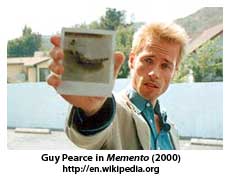Arguably the best film from last year’s crop was, of course, overlooked in the Academy nominations for Best Picture. Memento, a remarkably innovative film by Christopher Nolan dazzled the crowd at its Sundance release and has won over just about everyone I know, except my eighty-nine-year-old father, who likes stories that travel neatly from point A to point B. Memento does everything but that.

The story takes traditional noir elements in a completely original direction. Guy Pearce plays an insurance investigator pursuing the man whom he believes murdered his wife. The pursuit, set in Burbank, takes him through a dirty underclass community and the obligatory meeting with a beautiful dark-haired femme-fatale, played by Carrie-Anne Moss. So far, familiar territory. But add that Leonard has acute short-term memory loss, forcing him to rewrite the past in order to remember and understand it on slips of paper and even tattoos. And add that Nolan presents the sequences of the story in reverse, so what we see first, happened last – the final sequence begins with its conclusion followed by the events leading up to it; the penultimate sequence then starts with its conclusion, the beginning of the previous sequence, and goes from there… You really need two times through the film to understand its structure.
In creating so original a narrative, Nolan advances the noir tradition, which has grown darker and darker since Roman Polanski’s Chinatown. Beyond probing the moral and psychological ambiguities of life in the modern world, Memento says that we can’t even tell the story of these ambiguities with certainty – all of our perceptions get filtered through our fragmented consciousness, which itself is conflicted by our deepest desires. Mr. Kant, meet Mr. Freud.
That being said, the film holds our attention with its moodiness and crisp pacing even if we can’t define the term “postmodernism.” Everything about this film is good; except perhaps the characters, but they are all damned souls, so what do we expect.
